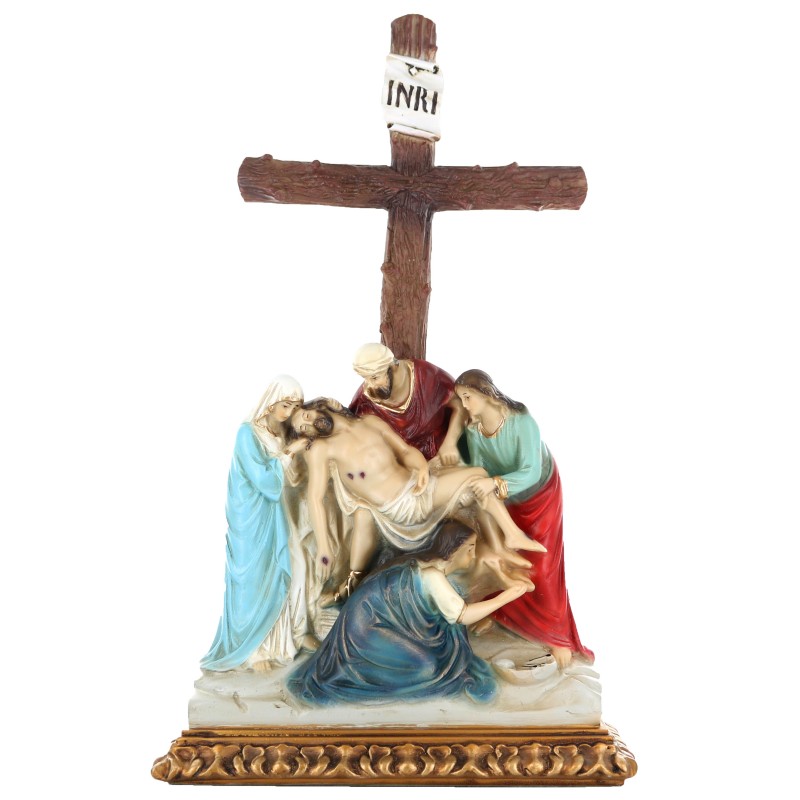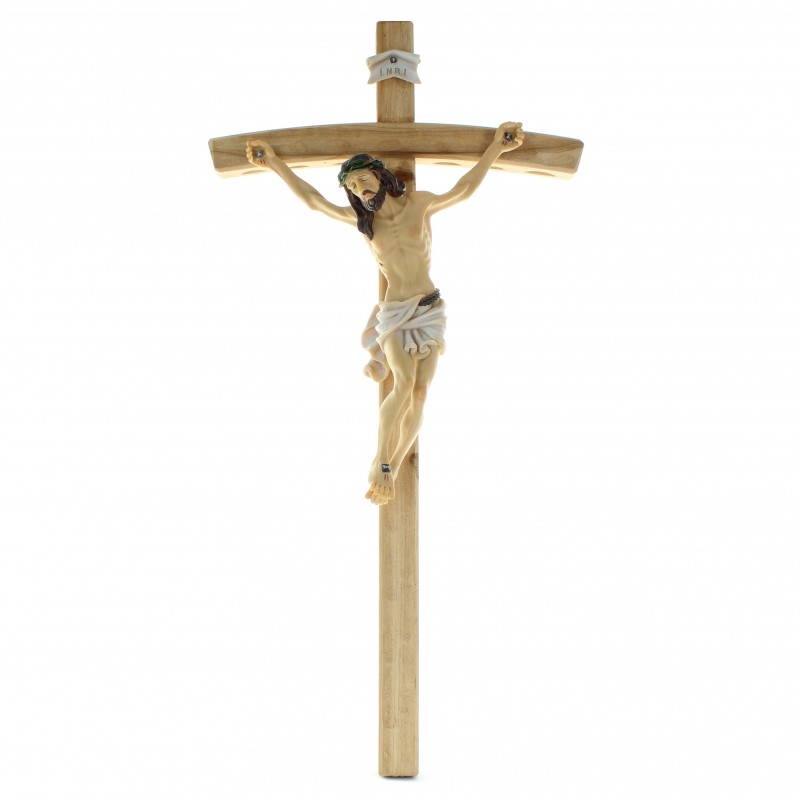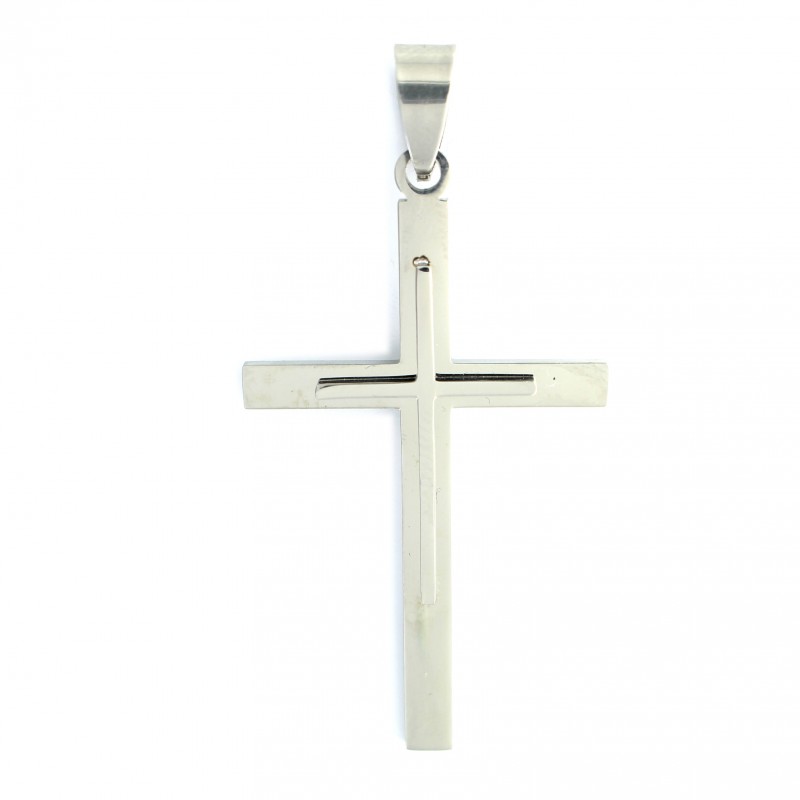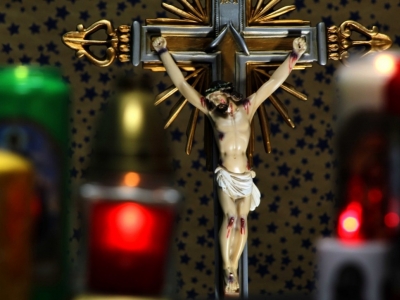The cross of Jesus is a strong symbol of the Christian world. It is a sign of recognition, remembrance and gathering, but it is also very intriguing because of its origin and meanings. For many Christians, carrying a cross of Jesus represents their faith in Christianity and the mystery of the Holy Trinity.
Why is the Holy Cross of Jesus invoked? What is the basis of this powerful sign? Starting with what the Gospels tell us about the Passion of Christ and the symbols associated with the Cross of Jesus, we will explore the representations and meanings of the Cross of Jesus.
The Cross of Jesus: what the Gospels tell us about it and the questions it raises
The four gospels recount the passion of Christ. Each of them gives a different angle and view. However, their accounts all focus on a chronological view of the crucifixion with the cross at its centre. We take up these accounts here, focusing on the mentions of the cross.
What the Gospels tell us about the cross of Jesus?
As the passion narratives unfold in the Gospels, the cross is the focus of attention on several occasions. This gives us the opportunity to learn more about this Christian sign.
Who carries the cross of Jesus?
According to Mark, Matthew and Luke, Simon of Cyrene was a labourer returning from the fields who was requisitioned to carry the cross behind Jesus. This character appears in three of the four Gospels and is not to be confused with Simon Peter. This disciple of Jesus he rechristened saying: "You are Peter and on this rock I will build my church" (Matthew 16:18-19).
According to the readings and interpretations, Simon carried the cross for Jesus or helped Jesus carry the cross. Only John mentions that Jesus himself carried the cross.
Who brought Jesus down from the cross?
After Jesus' death, Joseph of Arimathea, a disciple of Jesus, asks Pilate if he could remove the body. The meaning of remove here is to take him away to attend his funeral, not to remove him from the cross. It was probably Pilate's soldiers who removed Jesus from the cross and entrusted him to his mother (13th station of the Way of the Cross). Joseph, on the other hand, took charge of burying him with dignity in a shroud and in a tomb that Joseph possessed near Mount Golgotha.
The descent from the cross in the thirteenth station of the Stations of the Cross, depicting John, Mary Magdalene, Mary and a group of women at her side, is especially found in iconography that has inspired many artists.
Who made the cross of Jesus?
This is a question that is often asked. According to tradition, four types of wood were used for the cross: cedar, cypress, olive and palm.
Actually, it is not clear who made the cross of Jesus. It was a common torture object made from common woods. The wood of Jesus' cross was probably pine. The pieces of the real cross found in various places were of this species.
The use of the cross in Roman times
For the Romans, crucifixion was an infamous punishment reserved for troublemakers. It was in this context of threat to public order that Jesus was condemned to be crucified. It took the faith of the early Christians to turn this infamy into a sign of hope for a huge community over the centuries.

Scene of the descent from the cross in coloured resin 45cm 143€

Resin Crucifix 54 cm 59,90€

Silver cross in stainless steel 5 cm 7€
The crucifixion of Jesus
The crucifixion of Jesus is recorded in the four Gospels. This essential and creative moment for the Christian faith is particularly marked by the words spoken by Jesus on the cross. Questions arise about the duration of the crucifixion and who was present.
What are the seven words of Jesus on the cross?
The seven words of Jesus on the cross are a series of short sentences recorded in the Gospels. It is difficult to establish a precise chronology. These words have inspired great reflection and are an important part of the spirituality of the cross.
First word: Father, forgive them for they know not what they do.
This was said by Jesus as soon as he was put on the cross. It was a request for forgiveness for those who had participated in his condemnation and crucifixion.
Second word: Truly I say to you, today you will be with me in paradise. Here Jesus responds to one of the two thieves crucified with him who has just said: "Remember me when you are in your kingdom. This condemned man is referred to in tradition as the good thief.
Third word: Jesus turns to Mary and John. He says to Mary: "Woman, this is your son", and to John: "This is your mother". These words take on a deep meaning in the Christian tradition, since beyond the bond created between the disciple John and his mother, these words have been interpreted as Mary's spiritual motherhood towards the believers represented by the disciple Jesus loved.
Fourth word: Jesus cries out in a loud voice in Aramaic "Eloi, Eloi, lama sabbaqthani? (Ps 22) "My God, my God, why have you forsaken me? These words bring us back to the humanity of Christ, who thus expresses the supreme suffering of the feeling of abandonment. At the moment of crucifixion and in the face of pain, Jesus is a man among men.
Fifth word: "I thirst", pronounced "so that the Scripture may be fulfilled", comments the evangelist John. According to Luke, Jesus quotes Psalm 68:22: They gave me poison to eat and vinegar water to drink when I was thirsty, because the soldiers mocked Jesus with their pique (the most likely translation of vinegar in Greek).
Sixth word: Jesus said after taking this drink, "It is finished". These words express the completion of Jesus' life journey among us to redeem the sins of men. Moreover, his death is not a catastrophe but the very meaning of Jesus' life journey on earth.
Seventh word: Jesus cried out in a loud voice: "Father, into your hands I commend my spirit" before taking his last breath. As Luke points out, Jesus' last word is addressed to God as the first: "Did you not know that I must go to my Father?
Who was present with Jesus on the cross?
The gospels are not entirely clear on this part and sometimes contradict each other. However, it is reasonable to assume that there were several soldiers, Jewish officials, the two thieves and many women who were at a distance. The contradictions appear especially with the gospel of John. The other three evangelists report that all the disciples fled and do not mention Mary, the mother of Jesus. However, the evangelist John explicitly reports that John (himself) and Mary were present when recounting what Jesus said to John and Mary.
How long did Jesus stay on the cross?
Here too there are contradictions between the gospels, probably due to translation errors. According to Mark he was put on the cross at the third hour and Jesus expired at the sixth hour when darkness fell. So that is about three hours, and that is certainly the time we need to remember
The symbolism around the cross of Jesus and its representations
In ancient times, the cross of Jesus was an object of torture and death and became a symbol of recognition and reunion for Christians. Indeed, the cross of Jesus symbolises the salvation of mankind. In his death, Jesus Christ redeemed original sin and granted mankind divine forgiveness.
How long has the symbol of the cross of Jesus existed?
The Christian symbol of the cross did not appear immediately after the crucifixion of Jesus. It began to be reproduced from the second century onwards. The cross as an official symbol of Christianity became established from the reign of Constantine. It was also during this period that in 327 Saint Helena, mother of Emperor Constantine, went to the Holy Land and found and brought back the True Cross.
The design of the Latin cross churches is the result of this desire to be inspired by the cross of Jesus.
Why is the Holy Cross of Jesus invoked?
On the cross, Jesus conquered death, the cross became the glorious sign of the resurrection, it is the sacred symbol of Christianity. The cross is also the sign of Jesus' offering of love for humanity.
The sign of the cross or the sign of the cross
Tertullian, an ancient author, reports that the sign of the cross is usually practised by Christians as a sign of belonging to the community and for protection. It is found today among Catholics, Orthodox and some Protestant denominations. Depending on the era and branch of Christianity, it consists of placing two, three or five fingers of the right hand on the forehead, then on the chest, and finally from one shoulder to the other: first the left shoulder and then the right for Catholics, and the right and then the left for the Orthodox. For some people, the sign of the cross can have very important protective virtues, sometimes approaching superstition.
Different representations of the Cross of Jesus: Crucifix and Christic Cross
The crucifix is the representation of the cross with Christ on it. Commonly used by Catholics and Orthodox, some Protestant churches prefer the Christ Cross, a simple cross without the representation of Christ.
In certain events, such as Holy Week, the cross is carried in processions followed by large crowds.
Other signs on the cross of Jesus
The acronym INRI
Over time, there has been confusion: the sign (patibulum) on the cross of Christ is sometimes seen as a white scarf, the acronym INRI can be read as Henry...
In Roman times, the patibulum was the sign that the condemned man carried to the place of his torture. He explained his charge. The sign was then nailed to the cross.
INRI stands for Iesus Nazarenus Rex Iudaeorum, i.e. 'Jesus the Nazarene King of the Jews', and this inscription was probably an ironic message from Pontius Pilate to the Jews.
H4 The skull and crossbones on the crucifix
There are also crucifixes with a skull and crossbones. There are several meanings for this:
- The skull symbolises Christ's victory over death
- It evokes Adam's skull
- It is a reminder of man's mortality
- It recalls the link with Mount Golgotha where Christ was crucified. In Hebrew, golgotha means skull.
A strong symbol sometimes abused
The cross of Jesus, a strong symbol of our Christian civilisation, has sometimes been misused and misinterpreted. The inverted cross, cross with a skull.
The inverted cross is also called St Peter's Cross. Peter was martyred under Nero's reign and condemned to crucifixion. The Apostle Peter considered himself unworthy to die like Jesus and asked to be crucified in this way.
However, the cross was used as a symbol of anti-Christianity and also as a representation of Satan.
The Cross of Jesus after the Passion of Christ has raised many questions about its mysteries and representations. It has survived disagreements among Christians and remains today the sign of recognition for all, Catholics, Orthodox and Protestants.
The cross of Jesus, emblem of Christ's passion, may have been interpreted by Christians as a painful reminder. This is not the case. The Passion of Christ was the fulfilment of his passage on earth. The cross became the symbol of victory over death, of the bond between humanity and God.
Today it is a powerful symbol, a sign of gathering, of recognition of the whole Christian community. Our civilisation, shaped by Christianity, is marked by this sign, and everyone who sees it knows its meaning.
Prayer for the Cross of Jesus
Lord Jesus, we come to you to thank you for your sacrifice on the cross.
We thank you for your unconditional love for us, which led us to endure suffering and death in order to save us.
We thank you for your resurrection which gives us the hope of eternal life.
We ask you to give us the grace to carry our cross with courage and perseverance, as you did.
We ask you to help us to understand your love for us and to live according to your will.
We ask you to bless all those who carry your cross today, to protect them from all harm and to give them the strength to continue to go forward.
We thank you for all the blessings you have given us through your cross and we entrust our lives and souls to you.
Amen



 The Mystery of the Five Wounds of Christ: A Profound Exploration of Their Spiri
The Mystery of the Five Wounds of Christ: A Profound Exploration of Their Spiri  Women's religious orders: A heritage of service and education
Women's religious orders: A heritage of service and education  What is Secours Catholique?
What is Secours Catholique?  Jesus' 40 Days in the Desert: A Spiritual Exploration
Jesus' 40 Days in the Desert: A Spiritual Exploration  In un mondo di connessioni costanti e distrazioni digitali, la Quaresima si sta
In un mondo di connessioni costanti e distrazioni digitali, la Quaresima si sta